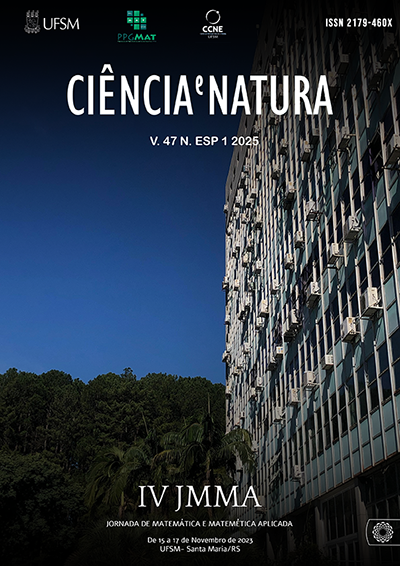Uma Implementação do Algoritmo de Localização de Autovalores de Grafos Threshold em Python
DOI:
https://doi.org/10.5902/2179460X90148Palavras-chave:
Grafo threshold, Algoritmo Diagonalize, Implementação, PythonResumo
Um grafo threshold de ordem n pode ser caracterizado através de uma sequência binária (b1, b2, … , bn). Apresentaremos os detalhes do algoritmo conhecido como Diagonalize, que fornece a localização dos autovalores da matriz de adjacência de um grafo threshold apenas baseando-se na geometria deste, sem recorrer a manipulações diretas com a matriz em si. Veremos que a caracterização binária é uma ferramenta facilitadora para uma implementação linear deste algoritmo em Python.
Downloads
Referências
Jacobs, D. P. & Trevisan, V. (2011). Locating the eigenvalues of trees. Linear Algebra and its Applications, 434(1):81–88. doi: 10.1016/j.laa.2010.08.006. DOI: https://doi.org/10.1016/j.laa.2010.08.006
Jacobs, D. P., Trevisan, V., & Tura, F. (2013). Eigenvalue location in threshold graphs. Linear Algebra and its applications, 439(10):2762–2773. Recovered from: https://www.sciencedirect.com/science/article/pii/S002437951300493X. DOI: https://doi.org/10.1016/j.laa.2013.07.030
Jacobs, D. P., Trevisan, V., & Tura, F. C. (2018). Eigenvalue location in cographs. Discrete Applied Mathematics, 245:220–235. doi: https://doi.org/10.1016/j.dam.2017.02.007. DOI: https://doi.org/10.1016/j.dam.2017.02.007
Lipschutz, S. & Lipson, M. L. (2011). ´Algebra linear. (2nd ed.). Bookman.
Mahadev, N. V. & Peled, U. N. (1995). Threshold graphs and related topics. Elsevier.
Poole, D. (2004). ´Algebra linear. (56th ed.). Cengage Learning.
Tura, F. C. (2013). O espectro de grafos threshold e aplicações (Tese submetida ao Programa de P´os-Graduação em Matem´atica Aplicada). Instituto de Matem´atica, Universidade Federal do Rio Grande do Sul, Porto Alegre, RS, Brasil.
Downloads
Publicado
Como Citar
Edição
Seção
Licença
Copyright (c) 2025 Ciência e Natura

Este trabalho está licenciado sob uma licença Creative Commons Attribution-NonCommercial-ShareAlike 4.0 International License.
Para acessar a DECLARAÇÃO DE ORIGINALIDADE E EXCLUSIVIDADE E CESSÃO DE DIREITOS AUTORAIS clique aqui.
Diretrizes Éticas para Publicação de Revistas
A revista Ciência e Natura está empenhada em garantir a ética na publicação e na qualidade dos artigos.
A conformidade com padrões de comportamento ético é, portanto, esperada de todas as partes envolvidas: Autores, Editores e Revisores.
Em particular,
Autores: Os Autores devem apresentar uma discussão objetiva sobre a importância do trabalho de pesquisa, bem como detalhes e referências suficientes para permitir que outros reproduzam as experiências. Declarações fraudulentas ou intencionalmente incorretas constituem comportamento antiético e são inaceitáveis. Artigos de Revisão também devem ser objetivos, abrangentes e relatos precisos do estado da arte. Os Autores devem assegurar que seu trabalho é uma obra totalmente original, e se o trabalho e / ou palavras de outros têm sido utilizadas, isso tem sido devidamente reconhecido. O plágio em todas as suas formas constitui um comportamento publicitário não ético e é inaceitável. Submeter o mesmo manuscrito a mais de um jornal simultaneamente constitui um comportamento publicitário não ético e é inaceitável. Os Autores não devem submeter artigos que descrevam essencialmente a mesma pesquisa a mais de uma revista. O Autor correspondente deve garantir que haja um consenso total de todos os Co-autores na aprovação da versão final do artigo e sua submissão para publicação.
Editores: Os Editores devem avaliar manuscritos exclusivamente com base no seu mérito acadêmico. Um Editor não deve usar informações não publicadas na própria pesquisa do Editor sem o consentimento expresso por escrito do Autor. Os Editores devem tomar medidas de resposta razoável quando tiverem sido apresentadas queixas éticas relativas a um manuscrito submetido ou publicado.
Revisores: Todos os manuscritos recebidos para revisão devem ser tratados como documentos confidenciais. As informações ou ideias privilegiadas obtidas através da análise por pares devem ser mantidas confidenciais e não utilizadas para vantagens pessoais. As revisões devem ser conduzidas objetivamente e as observações devem ser formuladas claramente com argumentos de apoio, de modo que os Autores possam usá-los para melhorar o artigo. Qualquer Revisor selecionado que se sinta desqualificado para rever a pesquisa relatada em um manuscrito ou sabe que sua rápida revisão será impossível deve notificar o Editor e desculpar-se do processo de revisão. Os Revisores não devem considerar manuscritos nos quais tenham conflitos de interesse resultantes de relacionamentos ou conexões competitivas, colaborativas ou outras conexões com qualquer dos autores, empresas ou instituições conectadas aos documentos.






